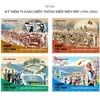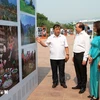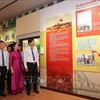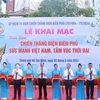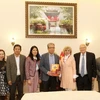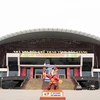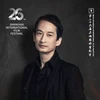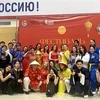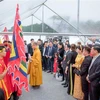Ha Noi is the only locality in the country with many ancient citadels. Most popular are Co Loa, Thang Long Royal Citadel and Son Tay.
Located in Dong Anh district, 17km from the centre of Hanoi, Co Loa citadel has numerous archaeological sites excavated. Discoveries have shown the continuous development of the culture from the Bronze, Stone and Iron ages to the pinnacle of Dong Son culture.
Archaeologists said that Co Loa was the most ancient citadel in Vietnam with unique architecture and scale. The citadel used to be the capital of the country under King An Duong Vuong dynasty in the third century BC and the Ngo Quyen era in the 10th century.
The archaeological relics show the techniques for building ramparts and reveal military tactics from the early days of the ancient Vietnamese people who took advantages of the natural terrain to build meandering citadel.
On the 6 th day of the first lunar month of the year, local people hold an annual festival to remember the citadel builders and King An Duong Vuong.
Thang Long Imperial Citadel has been recognised as a world cultural heritage site, as it boasts treasures, both buried and visible, more than 1,300 years old.
The site encompasses the No. 18 Hoang Dieu archaeological site and the central axis of the Hanoi ancient citadel, which are nestled in the Forbidden Area in the heart of Thang Long Imperial Citadel.
At the No. 18 Hoang Dieu archaeological site, scientists found imprints typical of the Ly, Tran and Le dynasties that revealed much about the origin of Thang Long Imperial Citadel more than 1,300 years ago.
Lying adjacent to Kinh Thien Palace to the west, the No. 18 Hoang Dieu archeological site is a component of the Forbidden Area from the Ly dynasty to the end of the Le Trung Hung era.
From December 2002 to March 2004, archaeologists excavated numerous artefacts on 19,000 sq. m of the site, exposing layers of cultures of different dynasties which reigned in Vietnam and proving that Thang Long Imperial City played a key role as a political centre throughout the 1,300 years.
Architectural vestiges of palaces, pavilions, and the foundations of architectural structures of the Imperial Citadel have also been revealed.
A system of ancient wells was exposed, including two believed to exist in the Dai La era, two built under the Ly dynasty, two under the Tran dynasty, and six under the Le dynasty. These wells have a similar shape and size to those found in the forbidden citadels in Japan , China and the Democratic People’s Republic of Korea .
The No. 18 Hoang Dieu archaeological site has supplied clear evidence of the site’s important role throughout the nation’s history, from 1010 to 1789.
Situated to the east of the No. 18 Hoang Dieu archaeological site is Hanoi ’s ancient citadel area - the remainder of the central axis of the Vauban building.
Many buildings inside the citadel were constructed by French colonists during the 1880s after they occupied Hanoi . There are also some important buildings built after 1954, which served as the headquarters of the Defence Ministry until 2004.
Son Tay citadel, covering 16 ha in Son Tay twonship, 40km from Hanoi’s centre, has a military rampart with special architectural features.
The ancient military architecture was built under the Nguyen dynasty, under the reign of King Minh Mang in 1822.
The citadel was built with an overall square shape, with each wall about 400m long and 5m high, built in the Vauban style.
One of the four main ports, or entries, the south gate was called Tien (front) gate; the north was the Hau (back) port, the east, Ta (left) main and the west, Huu (right) main.
After nearly 200 years and with much devastation, ancient Son Tay citadel now has only the walls, doors, door posts, two cannons and some ruins at Vong Lau, the foundation of Kinh Thien palace and the wells.
Hanoi is investing in preserving those citadels to attract tourists to the city./.
Located in Dong Anh district, 17km from the centre of Hanoi, Co Loa citadel has numerous archaeological sites excavated. Discoveries have shown the continuous development of the culture from the Bronze, Stone and Iron ages to the pinnacle of Dong Son culture.
Archaeologists said that Co Loa was the most ancient citadel in Vietnam with unique architecture and scale. The citadel used to be the capital of the country under King An Duong Vuong dynasty in the third century BC and the Ngo Quyen era in the 10th century.
The archaeological relics show the techniques for building ramparts and reveal military tactics from the early days of the ancient Vietnamese people who took advantages of the natural terrain to build meandering citadel.
On the 6 th day of the first lunar month of the year, local people hold an annual festival to remember the citadel builders and King An Duong Vuong.
Thang Long Imperial Citadel has been recognised as a world cultural heritage site, as it boasts treasures, both buried and visible, more than 1,300 years old.
The site encompasses the No. 18 Hoang Dieu archaeological site and the central axis of the Hanoi ancient citadel, which are nestled in the Forbidden Area in the heart of Thang Long Imperial Citadel.
At the No. 18 Hoang Dieu archaeological site, scientists found imprints typical of the Ly, Tran and Le dynasties that revealed much about the origin of Thang Long Imperial Citadel more than 1,300 years ago.
Lying adjacent to Kinh Thien Palace to the west, the No. 18 Hoang Dieu archeological site is a component of the Forbidden Area from the Ly dynasty to the end of the Le Trung Hung era.
From December 2002 to March 2004, archaeologists excavated numerous artefacts on 19,000 sq. m of the site, exposing layers of cultures of different dynasties which reigned in Vietnam and proving that Thang Long Imperial City played a key role as a political centre throughout the 1,300 years.
Architectural vestiges of palaces, pavilions, and the foundations of architectural structures of the Imperial Citadel have also been revealed.
A system of ancient wells was exposed, including two believed to exist in the Dai La era, two built under the Ly dynasty, two under the Tran dynasty, and six under the Le dynasty. These wells have a similar shape and size to those found in the forbidden citadels in Japan , China and the Democratic People’s Republic of Korea .
The No. 18 Hoang Dieu archaeological site has supplied clear evidence of the site’s important role throughout the nation’s history, from 1010 to 1789.
Situated to the east of the No. 18 Hoang Dieu archaeological site is Hanoi ’s ancient citadel area - the remainder of the central axis of the Vauban building.
Many buildings inside the citadel were constructed by French colonists during the 1880s after they occupied Hanoi . There are also some important buildings built after 1954, which served as the headquarters of the Defence Ministry until 2004.
Son Tay citadel, covering 16 ha in Son Tay twonship, 40km from Hanoi’s centre, has a military rampart with special architectural features.
The ancient military architecture was built under the Nguyen dynasty, under the reign of King Minh Mang in 1822.
The citadel was built with an overall square shape, with each wall about 400m long and 5m high, built in the Vauban style.
One of the four main ports, or entries, the south gate was called Tien (front) gate; the north was the Hau (back) port, the east, Ta (left) main and the west, Huu (right) main.
After nearly 200 years and with much devastation, ancient Son Tay citadel now has only the walls, doors, door posts, two cannons and some ruins at Vong Lau, the foundation of Kinh Thien palace and the wells.
Hanoi is investing in preserving those citadels to attract tourists to the city./.
